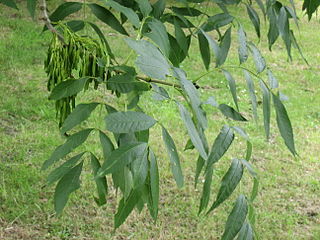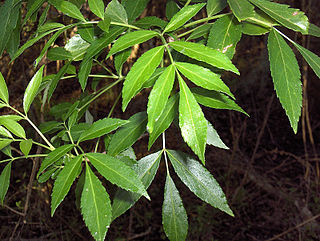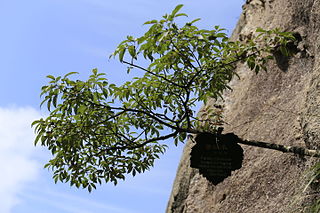
Fraxinus, commonly called ash, is a genus of plants in the olive and lilac family, Oleaceae, and comprises 45–65 species of usually medium-to-large trees, most of which are deciduous trees, although some subtropical species are evergreen trees. The genus is widespread throughout much of Europe, Asia, and North America.

Fraxinus americana, the white ash or American ash, is a fast-growing species of ash tree native to eastern and central North America.

Fraxinus excelsior, known as the ash, or European ash or common ash to distinguish it from other types of ash, is a flowering plant species in the olive family Oleaceae. It is native throughout mainland Europe east to the Caucasus and Alborz mountains, and Great Britain and Ireland, the latter determining its western boundary. The northernmost location is in the Trondheimsfjord region of Norway. The species is widely cultivated and reportedly naturalised in New Zealand and in scattered locales in the United States and Canada.

Fraxinus pennsylvanica, the green ash or red ash, is a species of ash native to eastern and central North America, from Nova Scotia west to southeastern Alberta and eastern Colorado, south to northern Florida, and southwest to Oklahoma and eastern Texas. It has spread and become naturalized in much of the western United States and also in Europe from Spain to Russia.

Fraxinus ornus, the manna ash or South European flowering ash, is a species of Fraxinus native to Southern Europe and Southwestern Asia, from Spain and Italy north to Austria and the Czech Republic, and east through the Balkans, Turkey, and western Syria to Lebanon and Armenia.

Chionanthus virginicus is a tree native to the savannas and lowlands of the northeastern and southeastern United States, from Massachusetts south to Florida, and west to Oklahoma and Texas.

Fraxinus profunda, the pumpkin ash, is a species of ash (Fraxinus) native to eastern North America, where it has a scattered distribution on the Atlantic coastal plain and interior lowland river valleys from the Lake Erie basin in Ontario and New York west to Illinois, southwest to Missouri and southeast to northern Florida. It grows in bottomland habitats, such as swamps, floodplains and riverbanks. It is threatened by the emerald ash borer, an invasive insect which has caused widespread destruction of ash trees in eastern North America.

Anisophyllea griffithii is a species of tree in the family Anisophylleaceae. It grows up to 36 metres (120 ft) tall. The species is native to Peninsular Malaysia, Singapore and Borneo.
Hopea griffithii is a tree in the family Dipterocarpaceae. It is named for the British doctor and naturalist William Griffith.

Fraxinus caroliniana, the pop ash, Florida ash, swamp ash, Carolina ash, or water ash, is a species of ash tree native from Cuba through the subtropical Southeastern United States from southern Virginia to Texas. It was originally described by the botanist Philip Miller. It is a small tree about 40 ft. Leaves are compound, opposite, 7–12 in long, leaflets 5–7 in, ovate to oblong, coarsely serrate or entire, 3–6 in long, 2–3 in wide. Fruit is frequently 3-winged (samara) with flat seed portion; seed sometimes a bright violet color. It is the smallest of eastern North American ash species, wood light, soft, weak, 22 lbs./cu.ft. Typical to coastal swamps and subtropical lowlands. Like other species in the section Melioides, Fraxinus caroliniana is dioecious, with male and female flowers produced on separate individuals.
Beilschmiedia bancroftii is a tree species in the family Lauraceae. It is native to Queensland in Australia. Common names include yellow walnut, yellow nut and canary ash.

Fraxinus hubeiensis is a species of ash native to Hubei province in China.

Fraxinus floribunda is a species of ash native to South Asia, East Asia, and Southeast Asia. It is known from Afghanistan, Pakistan, Nepal, Assam, Bhutan, Laos, Myanmar (Burma), Thailand, Vietnam, the Ryukyu Islands, and parts of China.

Fraxinus cuspidata, the fragrant ash, is a tree native to northern Mexico and the southwestern United States. It has been reported from Nuevo León, Coahuila, Chihuahua, Tamaulipas, Texas, New Mexico, Arizona and Nevada.

Fraxinus uhdei, commonly known as tropical ash or Shamel ash, is a species of tree native to Mexico and Central America. It is commonly planted as a street tree in Mexico and the southwestern United States. It has also been planted and spread from cultivation in Hawaii, where it is now considered an invasive species.

Fraxinus sogdiana, known as the Tianshan ash, is a species of flowering plant belonging to the family Oleaceae.

Fraxinus insularis, the Chinese flowering ash or island ash, is a species of flowering plant in the family Oleaceae, native to central and southeastern China, Hainan, Taiwan, the Ryukyu Islands, and Yakushima, Japan. Its leaves produce a number of secoiridoid glucosides.
Fraxinus longicuspis, the taper-tip ash or Japanese ash, is a species of flowering plant in the family Oleaceae, native to the mountains of central and southern Japan. A deciduous tree, it is hardy to USDA zone 5. It is used as a street tree in a few cities around the world.
Fraxinus greggii, the littleleaf ash or Gregg's ash, is a species of flowering plant in the family Oleaceae, native to Texas and Mexico. A xerophytic shrub or scrubby tree reaching 6 m (20 ft), it is suitable for screens and containers. There is a cultivar, 'Libby Davison'.
Fraxinus chiisanensis, the Jirisan ash, is a species of flowering plant in the family Oleaceae, native to South Korea. With only about 20,000 mature trees found in nine locations, it is assessed as Endangered due to severe population fragmentation, and some logging pressure. In spite of its Endangered status, it is still dominant in those streamside mountain forests where it does occur.
















